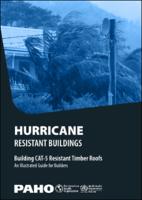Hurricane Resistant Buildings. Building CAT-5 Resistant Timber Roofs, An Illustrated Guide for Builders
| dc.date.accessioned | 2022 | |
| dc.date.available | 2022 | |
| dc.date.issued | 2022 | |
| dc.identifier.citation | Pan American Health Organization. Hurricane resistant buildings. Building CAT-5 resistant timber roofs, an illustrated guide for builders. Washington, DC: PAHO; 2022. Available from: https://doi.org/10.37774/9789275125700. | en_US |
| dc.identifier.isbn | 978-92-75-12571-7 (print version) | |
| dc.identifier.isbn | 978-92-75-12570-0 (PDF) | |
| dc.identifier.uri | https://iris.paho.org/handle/10665.2/56300 | |
| dc.description.abstract | The year 2020 set a record for the highest number of tropical/subtropical storms registered in a year. According to data from the National Oceanic and Atmospheric Administration (NOAA), the 2020 Atlantic Hurricane Season was the busiest year, with 29 events that caused economic losses estimated at US$ 50 billion, according to data from NOAA. Climate change has also brought with it an increased risk of the impact of higher intensity storms. The rise in water temperature in the Atlantic is causing a greater chance for hurricanes to develop. These natural events are not only more frequent but, in some cases, more catastrophic as well. One major impediment to resilience is the lack of suitably qualified or experienced professionals to design and build hurricane-resistant buildings in many countries that are typically the most affected. In most low-income countries, current building codes do not encourage the construction of robust structures that will withstand major hurricanes or are the building codes enforced. Additionally, reconstruction after the impact of such events is often rushed and poorly designed and executed. The Pan American Health Organization aims to reduce the recurrent damage following the impact of major hurricanes, with this illustrated, easy-to-follow guide to build Category 5-resistant roofs and external walls. These guidelines are to be used by local builders for the safe design and construction of roofs in hurricane-prone regions. True sustainability is achieved once people understand what they can do to help themselves and prevent future damage and losses. Therefore, we aim to provide graphic tools illustrating the safe and proper way to build and connect timber roofs to help minimize the loss of building infrastructure, impact on livelihoods and loss of lives. | en_US |
| dc.language.iso | en | en_US |
| dc.publisher | PAHO | en_US |
| dc.rights | Attribution-NonCommercial-ShareAlike 3.0 IGO | * |
| dc.rights.uri | http://creativecommons.org/licenses/by-nc-sa/3.0/igo/ | * |
| dc.subject | Hurricane | en_US |
| dc.subject | Tropical Storms | en_US |
| dc.subject | Storms | en_US |
| dc.subject | Infrastructure Projects | en_US |
| dc.subject | Disaster Emergencies | en_US |
| dc.title | Hurricane Resistant Buildings. Building CAT-5 Resistant Timber Roofs, An Illustrated Guide for Builders | en_US |
| dc.type | Procedures, manuals, guidelines | en_US |
| dc.rights.holder | Pan American Health Organization | en_US |
| dc.contributor.corporatename | Pan American Health Organization | en_US |
| paho.isfeatured | 0 | en_US |
| paho.publisher.country | United States | en_US |
| paho.publisher.city | Washington, D.C. | en_US |
| dc.identifier.doi | https://doi.org/10.37774/9789275125700 | |
| paho.source.centercode | US1.1 | en_US |
| paho.contributor.department | Health Emergencies (PHE) | en_US |
| paho.iswhotranslation | No | en_US |





